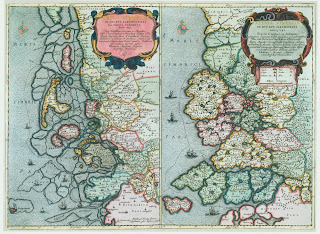Nordstrand, an island in the North Sea of the Frisian coast
 |
| Image from Wikipedia |
1634
Nordstrand, the home of Volkje Jurriaens, was once a much larger island encompassing many villages and thousands of people. In 1634 a great flood (Burchardi) swept the island destroying many of the villages and killing thousands.
Nordstrand sits off the western coast of the Jutland peninsula, near the port of Husum. Historically, it and the other islands and marshes in the area were called Uthlande (Utlande). They were identified as such because the islands and marches were inhabited by Frisians, a distinct ethnic group.
The island and city are located in the province of Schleswig, which can be imagined as that slice of the southern Jutland peninsula that separates Denmark from Germany. Schleswig has always been a melting pot of Danes, Germans, and Frisians. Today, Schleswig is divided between Germany and Denmark, Germany possessing both Nordstrand and Husum.
So, the question arises, "Who do the inhabitants of Nordstrand come from - Vikings, Danes, Saxons, Jutes, Frisian or Dutch?"
Roman History
The Eider River is the longest river in the northern German state of Schleswig-Holstein. Roman history places the Jute tribe to the north of the Eider River, Angles to the south, with Saxons in territory adjoining the Angles.
Middle Ages
During the Middle Ages, the population was a mixture of Danes, Saxons, and Northern Frisians. The Frisians inhabited the coastal areas. From the 8th to 13th centuries, Vikings in their longboats ranged throughout Europe. King Canute of Denmark even launched a successful invasion of England in 1016.
Schleswig
Schleswig is both a city and province in Germany. The Duchy of Schleswig appears as a political entity sometime around the 12th century.
 |
| detail Danorum Marca, 1588 by Mark Jorden |
The map of 1588 identifies at least 18 small villages on the island. Johannes Blaeu's later map of 1688 reveals the damage to the island, the flood destroying all but four of the villages, leaving only the villages of Pilworm (Pellwurm), Gpell, Gaickebull and Odenbull.
The question remains as to whether Jan Franz Van Husum and Volkje Jurriaens were Dutch or Frisian. That question probably can't be answered. But what is known is that the Frisian dialect was spoken throughout Nordstrand before the flood. Afterwards, the dialect was kept intact only on the small remaining island of Pellwurm where industrious farmers quickly rebuilt the dikes after the flood.
 |
| Detail, Johannes Blaeu's 1662 map of the Duchy of Schleswig |
Detail from Johannes Blaeu's, Ducatus Sleswicum sive Iutia Australis, 1662. Original image, Wikipedia.
Now look at a modern view of Nordstrand from Google maps.
 |
| Nordstrand, Google Maps 2013 |
Volkje and Annetje Jurriaens are both identified in later documents as coming from Nordstrand. What they or their parents did is lost to history, but reference is made to the fact that their parents died in the flood of 1634. In 1639, Volkje married Jan Franz Van Husum. Je is identified as coming from the neighboring town of Husum, but again there is little detail, other than a reference to his occupation as seafaring man in his marriage certificate to Volkje. A month after thier marriage, they sailed across the Atlantic in the ship Den Harinck, arriving in the port of New Amsterdam. Annetje also married and emigrated to the New Netherlands.
While the article is being written, you can visit the island in photos.
[Note about Spellings. The spelling of names vary for many reasons. Language differences account for many of the differences. Maps may contain Latin words, a marriage license might be in Dutch, and German, and Flemish might also enter into the equation. Then there is the lack of a uniform code of spelling that existed at the time. The first English dictionary was drafted in 1604, and Samuel Johnson's more famous Dictionary was not published until 1755. The first known Dutch dictionary was published by Cornelius Kiliaan in 1599.]







